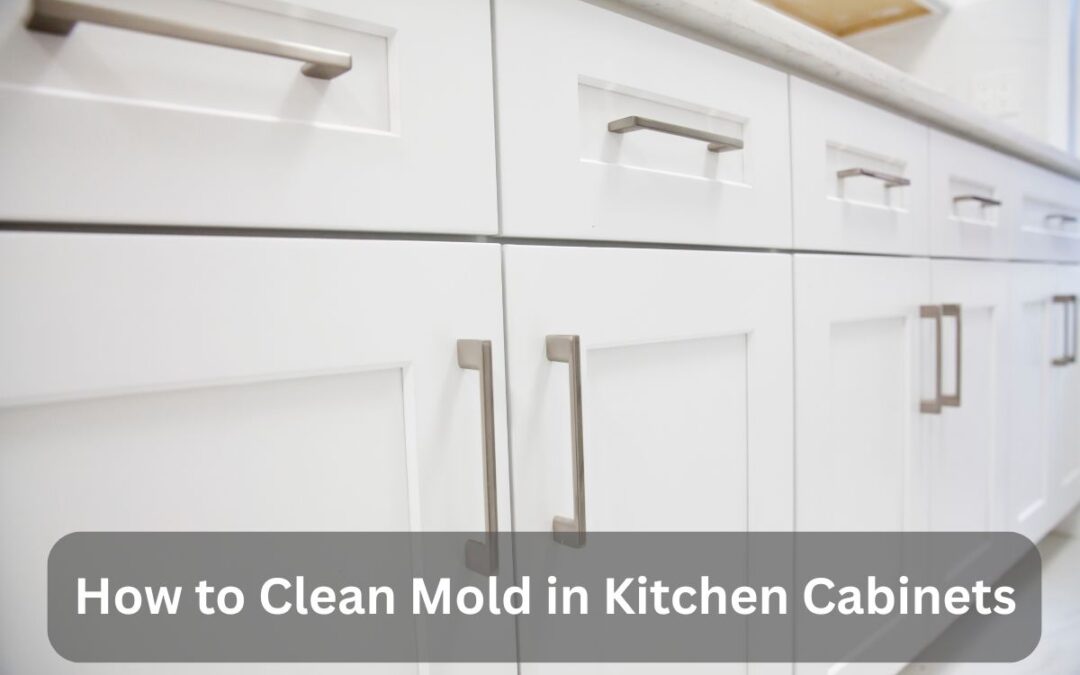Mold in kitchen cabinets is a fungal growth caused by moisture, poor ventilation, and organic residue such as wood fibers, food particles, or grease. Mold not only produces an unpleasant odor but also poses health risks and can damage the integrity of cabinetry if left untreated.
Key Takeaways
- Mold thrives in damp, poorly ventilated spaces such as under-sink cabinets or cupboards near appliances.
- Cleaning mold requires removing visible growth, disinfecting surfaces, and addressing the source of moisture.
- Household products like vinegar, baking soda, and hydrogen peroxide can be effective mold cleaners.
- Preventive measures, including sealing leaks and improving airflow, reduce the risk of future mold growth.
- Severe or recurring mold infestations may require professional remediation.
What Causes Mold in Kitchen Cabinets?
Kitchen cabinets provide an ideal environment for mold growth due to their enclosed design and frequent exposure to humidity. Common causes include:
- Plumbing leaks: Water leaking from pipes or sinks saturates cabinet wood and drywall.
- Steam and condensation: Cooking, dishwashers, and boiling water release moisture into nearby cabinets.
- Poor ventilation: Enclosed cabinets with little airflow allow moisture to remain trapped.
- Organic matter: Dust, food crumbs, and wooden surfaces provide nutrients for mold spores.
Signs of Mold in Kitchen Cabinets
Detecting mold early helps prevent larger infestations. Common indicators include:
- Musty or earthy odor.
- Dark spots, green or black patches on wood or shelving.
- White, powdery mildew along cabinet walls.
- Warped wood or peeling laminate.
- Allergy-like symptoms in occupants when near cabinets.
Step 1: Empty and Inspect Cabinets
The first step is to clear all items from the cabinet to assess the extent of the problem.
- Remove all dishes, food containers, and utensils.
- Discard any contaminated food or porous materials (e.g., cardboard, paper, cloth).
- Inspect the cabinet thoroughly, paying special attention to corners, hinges, and areas near plumbing.
- Identify the moisture source—such as a leaking pipe or condensation buildup—before cleaning.
Step 2: Protect Yourself Before Cleaning
Mold spores can cause irritation when inhaled or touched. Use proper protection before attempting removal.
- Wear gloves (rubber or disposable).
- Use safety goggles to prevent eye irritation.
- Wear an N95 mask or respirator to avoid inhaling spores.
- Keep the area ventilated by opening windows or using an exhaust fan.
Step 3: Clean Mold from Cabinet Surfaces
The cleaning method depends on the severity of mold and the cabinet material.
Natural Cleaning Solutions
- White Vinegar
- Spray undiluted white vinegar onto moldy surfaces.
- Let it sit for at least 1 hour.
- Wipe with a clean cloth and rinse lightly with warm water.
- Baking Soda
- Mix 1 teaspoon of baking soda with 2 cups of water.
- Spray on the mold and scrub with a brush.
- Wipe clean and spray again, leaving the surface to dry.
- Hydrogen Peroxide (3%)
- Spray directly onto moldy areas.
- Let it sit for 10 minutes.
- Scrub and wipe away residue.
Commercial Cleaners
For more severe cases, antifungal or mold-specific cleaning products may be used. Always follow manufacturer guidelines.
Fast Fact
Bleach is not recommended for porous surfaces such as wood because it may not penetrate deeply enough to kill mold at its roots.
Step 4: Dry Cabinets Completely
Mold will return quickly if moisture remains. After cleaning:
- Use a clean, dry towel to wipe surfaces.
- Leave cabinet doors open for several hours.
- Place fans or a dehumidifier nearby for faster drying.
- For under-sink cabinets, repair leaks and use a moisture absorber.
Step 5: Prevent Future Mold Growth
After removing mold, long-term prevention is essential.
- Fix leaks immediately: Monitor pipes, faucets, and appliances.
- Improve ventilation: Install vent fans in kitchens and leave cabinet doors open occasionally.
- Use sealants: Apply water-resistant finishes to cabinet interiors.
- Store properly: Avoid keeping damp sponges, cloths, or food packaging in cabinets.
- Add natural deodorizers: Place baking soda, activated charcoal, or silica gel packets inside to absorb moisture and odors.
Example: Step-by-Step in Action
A homeowner notices a musty smell under the sink. On inspection, black mold patches appear behind cleaning supplies.
- All items are removed and any affected cardboard boxes are discarded.
- Wearing gloves and a mask, the homeowner sprays vinegar onto the mold and lets it sit for an hour.
- The area is scrubbed, dried thoroughly, and a small leak from the drainpipe is fixed.
- Baking soda packets are placed inside the cabinet, and the doors are left open overnight.
Within a week, the smell disappears and mold does not return.
Mold in Wooden vs. Laminate Cabinets
Different cabinet materials require tailored care:
- Wood: Highly porous, so mold penetrates more deeply. Natural cleaners like vinegar and hydrogen peroxide are effective, but sanding and refinishing may be required for severe cases.
- Laminate: Less porous but still prone to mold on the surface. Cleaning solutions usually work without deeper treatment.
- Particleboard/MDF: More vulnerable to water damage and mold. If extensively contaminated, replacement may be more cost-effective.
When to Call a Professional
DIY methods work for small mold patches (less than 10 square feet). Seek professional remediation when:
- Mold covers a large area or recurs despite cleaning.
- There is structural damage to cabinets or walls.
- Household members develop respiratory symptoms linked to mold.
- The mold appears in hard-to-reach spaces behind cabinetry.
FAQs
Is mold in kitchen cabinets dangerous?
Yes. Mold exposure can cause respiratory irritation, allergies, or worsen asthma. Long-term exposure may pose health risks.
Can I paint over mold to hide it?
No. Painting or sealing over mold only traps spores beneath the surface. The mold will continue to grow and eventually resurface.
Will bleach kill mold in cabinets?
Bleach can kill surface mold on non-porous materials but is ineffective on porous wood, where mold roots remain. Vinegar or hydrogen peroxide are safer alternatives.
How do I stop mold from coming back?
Control moisture by fixing leaks, ventilating cabinets, and using dehumidifiers or moisture absorbers.
What’s the difference between mildew and mold?
Mildew is usually white or gray and powdery, while mold can be black, green, or fuzzy. Both require removal and prevention.
The Bottom Line
Mold in kitchen cabinets is both a health hazard and a sign of moisture problems. Effective treatment involves more than wiping away visible spots—it requires identifying the source of moisture, cleaning with natural or commercial products, drying thoroughly, and implementing preventive measures.
Small outbreaks can often be handled with household remedies such as vinegar, baking soda, and hydrogen peroxide. However, larger infestations or recurring mold may require professional remediation. With proper care, including regular inspections and moisture control, your kitchen cabinets can remain clean, safe, and mold-free.

As the chief content writer, Hassan Al Sarker works as a professional kitchen-based content creator at Kitchen Liker.
In addition to reviewing the content published on Kitchen Liker, he ensures that it is accurate, relevant, and helpful. As a result, all the reviews and information published at Kitchen Liker are neutral and userfriendly.
Hassan Al Sarker has a bachelor’s degree in Hotel and Tourism Management From the Newyork University. Before joining Kitchen Liker, he was a contributor at Kitchen Club, United States.

